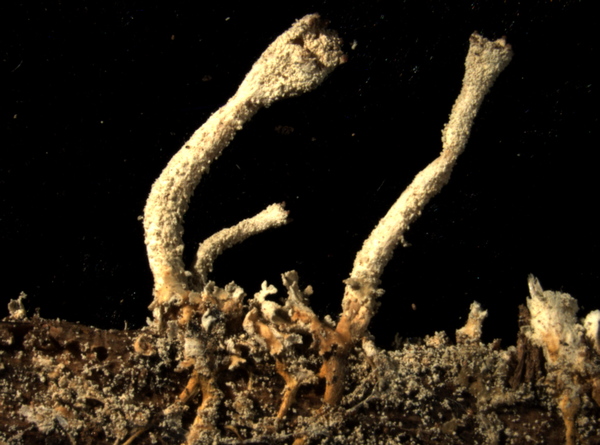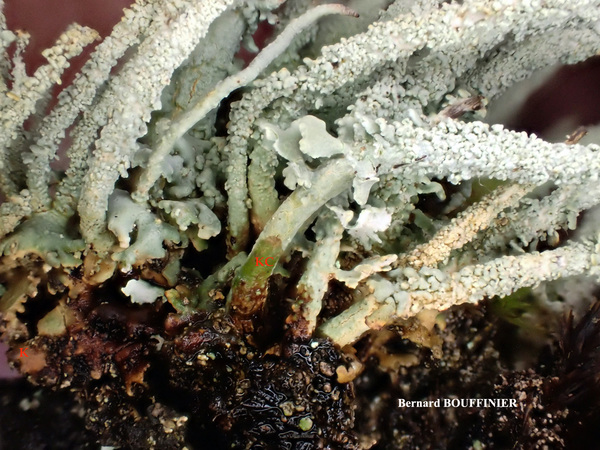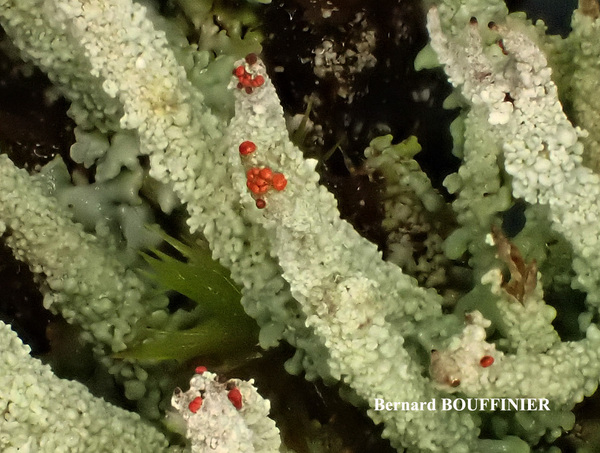Cladonia umbricola Tønsberg & Ahti
Norw. J. Bot., 27: 307, 1980
Synonyms:
Distribution:
Description: Primary thallus squamulose, usually persistent, the squamules 2-4 mm long, 1-2 mm wide, with deeply crenulated margins, grey-green on upper side, white and esorediate or sparsely sorediate beneath. Podetia mostly simple, hollow inside, 1-2(-3) cm tall, 0.5-1.5(-2) mm thick, the tips usually without cups, rarely with narrow, irregular, 1-2 mm wide cups, the surface greenish grey to whitish grey, smooth, ecorticate, usually esquamulose, farinose-sorediate up to the base. Apothecia rare, scarlet red, at the margins of cups or terminal. Asci 8-spored, clavate, thickened at apex, with a K/I+ blue tholus and a K/I+ strongly blue outer gelatinous sheath, Cladonia-type. Ascospores 1-celled, hyaline, ellipsoid. Pycnidia scarlet red, semi-immersed at the margins of cups, with a red jelly. Conidia hyaline, curved. Photobiont chlorococcoid. Spot tests: K-, C-, KC-, P-, UV+ white. Chemistry: squamatic acid, a rarer chemotype with thamnolic acid (K+ yellow, P+ yellow, UV-) is known from northern areas; rhodocladonic acid in apothecia and pycnidia. Note: a mainly western, oceanic to suboceanic species also present in North America, with a few southern records from the Iberian Peninsula and the Western Alps (Switzerland): it grows on decaying wood and at the base of trunks of conifers as well as on acidic soil in humid-shaded situations. To be looked for in Italy.
Growth form: Fruticose
Substrata: bark, soil, terricolous mosses, and plant debris
Photobiont: green algae other than Trentepohlia
Reproductive strategy: mainly asexual, by soredia, or soredia-like structures (e.g. blastidia)
Most common in areas with a humid-warm climate (e.g. most of Tyrrenian Italy)
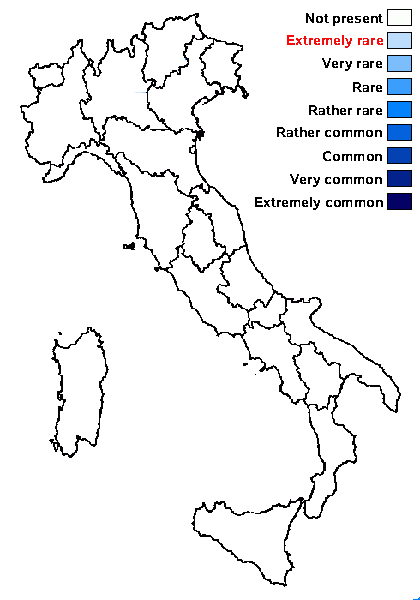
Predictive model
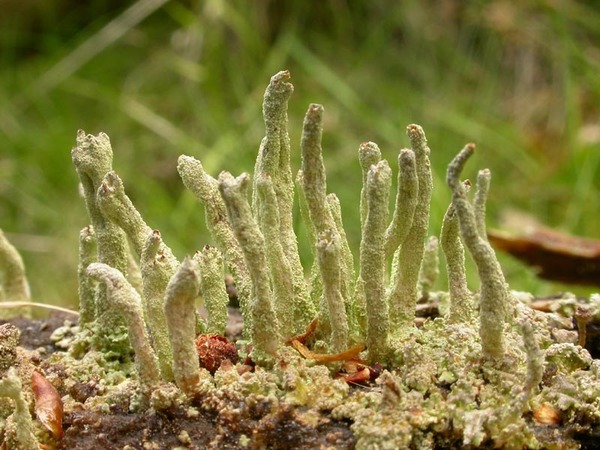
Einar Timdal - Source: http://www.nhm2.uio.no/botanisk/lav/Photo_Gallery/Cladonia/umbricola_G=Norway+SoerTroendelag+Oerland_D=20040519_O=Timdal_H=O-L129357_C=ET_I=1.jpg


Curtis Randall Björk – CC BY-SA 4.0
British Columbia, Vancouver Island, Albert Head 2013-10-02 On Pinus contorta by marine shore
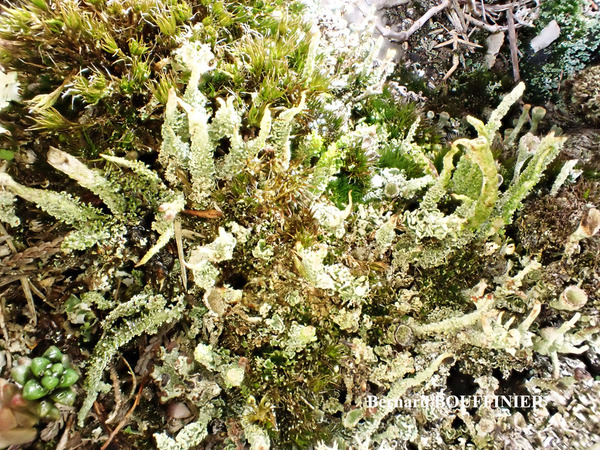
Bernard Bouffinier - Source: http://www.lichensmaritimes.org/index.php?task=fiche&lichen=1189&lang=en
France, Pointe du Guern

Bernard Bouffinier - Source: http://www.lichensmaritimes.org/index.php?task=fiche&lichen=1189&lang=en
France, Pointe du Guern
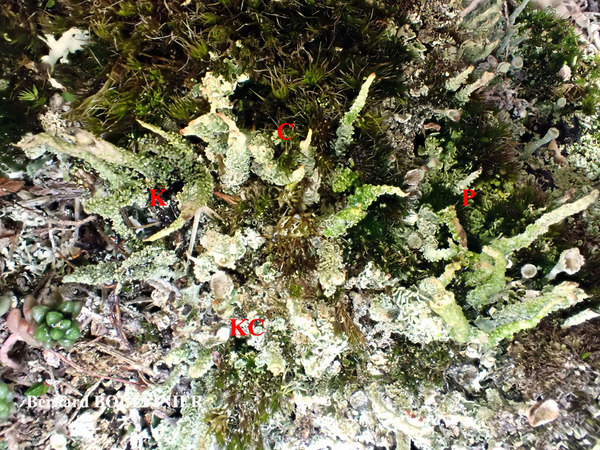
Bernard Bouffinier - Source: http://www.lichensmaritimes.org/index.php?task=fiche&lichen=1189&lang=en
France, Pointe du Guern
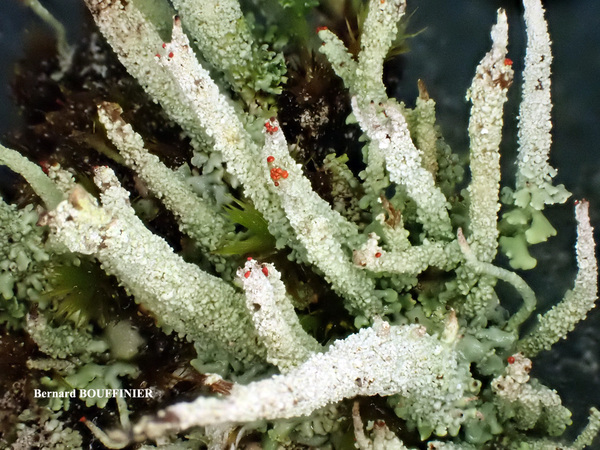
Bernard Bouffinier - Source: http://www.lichensmaritimes.org/index.php?task=fiche&lichen=1189&lang=en
France, Roc'h Vri
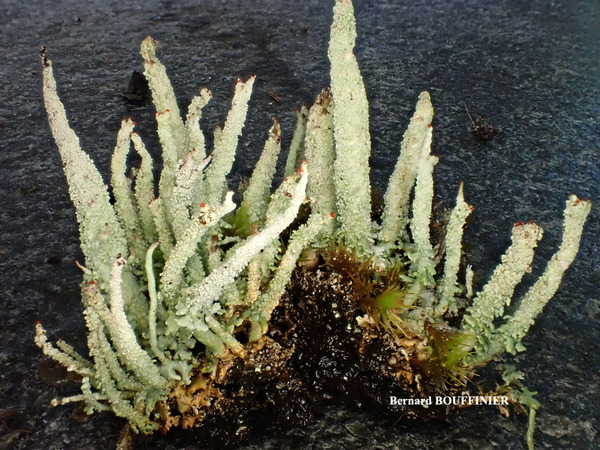
Bernard Bouffinier - Source: http://www.lichensmaritimes.org/index.php?task=fiche&lichen=1189&lang=en
France, Roc'h Vri
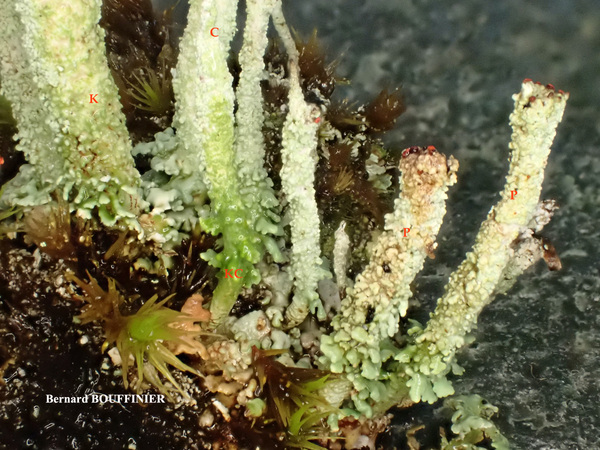
Bernard Bouffinier - Source: http://www.lichensmaritimes.org/index.php?task=fiche&lichen=1189&lang=en
France, Roc'h Vri
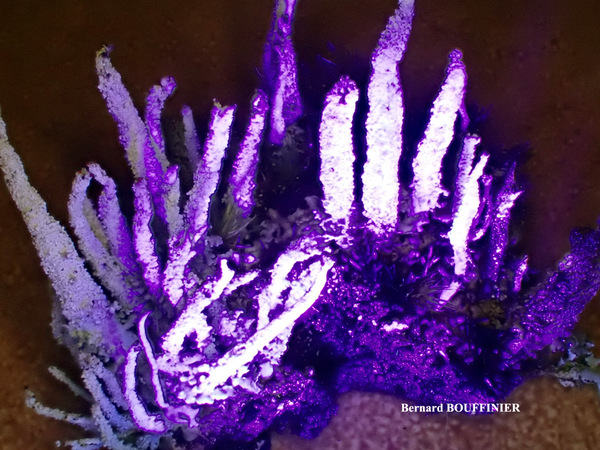
Bernard Bouffinier - Source: http://www.lichensmaritimes.org/index.php?task=fiche&lichen=1189&lang=en
France, Roc'h Vri
UV+
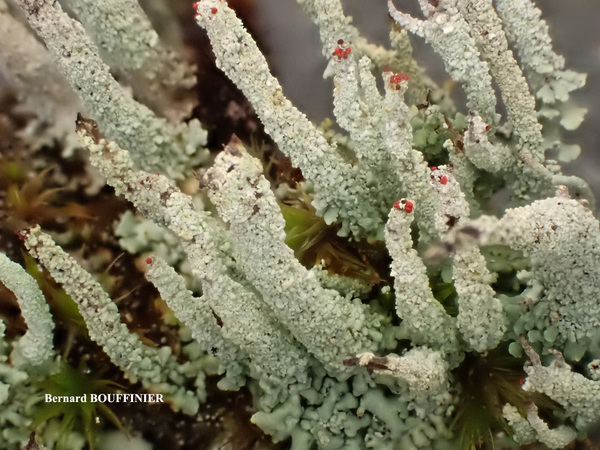
Bernard Bouffinier - Source: http://www.lichensmaritimes.org/index.php?task=fiche&lichen=1189&lang=en
France, Roc'h Vri
Growth form: Fruticose
Substrata: bark, soil, terricolous mosses, and plant debris
Photobiont: green algae other than Trentepohlia
Reproductive strategy: mainly asexual, by soredia, or soredia-like structures (e.g. blastidia)
Most common in areas with a humid-warm climate (e.g. most of Tyrrenian Italy)

Predictive model

Einar Timdal - Source: http://www.nhm2.uio.no/botanisk/lav/Photo_Gallery/Cladonia/umbricola_G=Norway+SoerTroendelag+Oerland_D=20040519_O=Timdal_H=O-L129357_C=ET_I=1.jpg


Curtis Randall Björk – CC BY-SA 4.0
British Columbia, Vancouver Island, Albert Head 2013-10-02 On Pinus contorta by marine shore

Bernard Bouffinier - Source: http://www.lichensmaritimes.org/index.php?task=fiche&lichen=1189&lang=en
France, Pointe du Guern

Bernard Bouffinier - Source: http://www.lichensmaritimes.org/index.php?task=fiche&lichen=1189&lang=en
France, Pointe du Guern

Bernard Bouffinier - Source: http://www.lichensmaritimes.org/index.php?task=fiche&lichen=1189&lang=en
France, Pointe du Guern

Bernard Bouffinier - Source: http://www.lichensmaritimes.org/index.php?task=fiche&lichen=1189&lang=en
France, Roc'h Vri

Bernard Bouffinier - Source: http://www.lichensmaritimes.org/index.php?task=fiche&lichen=1189&lang=en
France, Roc'h Vri

Bernard Bouffinier - Source: http://www.lichensmaritimes.org/index.php?task=fiche&lichen=1189&lang=en
France, Roc'h Vri

Bernard Bouffinier - Source: http://www.lichensmaritimes.org/index.php?task=fiche&lichen=1189&lang=en
France, Roc'h Vri
UV+

